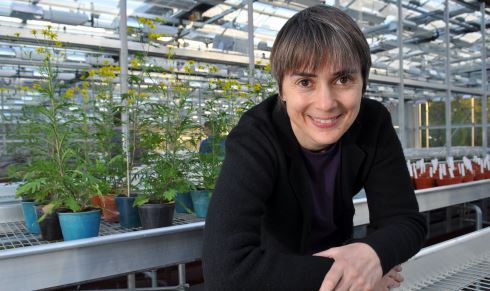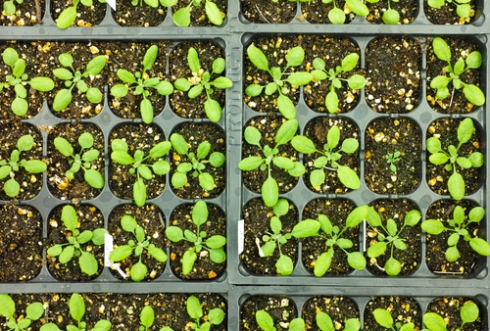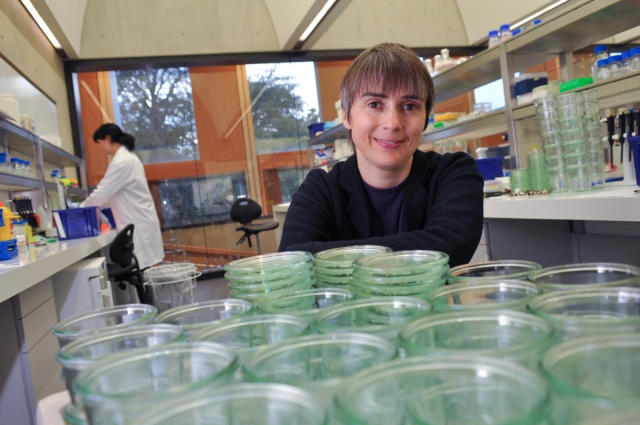"The prevailing culture in science is about competition and the lone brilliant-mind type scientist"

Plant geneticist Dame Ottoline Leyser talks to Alison Woollard about the difference between working with animal and plant genomes, and her work to make science more inclusive
The Biologist 64(4) p16-19
Dame Ottoline Leyser is a professor of plant development at the University of Cambridge. She directs the Sainsbury Laboratory, which aims to better understand the regulatory systems underlying plant growth and development.
After a PhD in genetics from Cambridge in 1990, Dame Ottoline worked in research positions at Indiana University and the University of York. Her group at Cambridge focuses on the role of plant hormones in the plasticity of plant development.
In the 2017 New Year honours, Leyser was made a dame (DBE) for services to plant science, science in society, and equality and diversity in science. The Biologist's Alison Woollard, who works on development in the nematode Caenorhabditis elegans at the University of Oxford, caught up with Dame Ottoline to discuss recent developments in plant science, GM crops and UK politics.
AW: Paint a picture of how you see plants – why do they enthuse you?
OL: Well, like you, my favourite question is the developmental question. How do you go from a single cell to a complex multicellular organism, with all the cells in the right place at the right time doing the right thing? It's just an extraordinary question – and I think plants do it in a more interesting way.
While both plants and animals have these very elegant regulatory systems encoded in their genome, at the end of embryogenesis in plants and animals, you end up with something that's very stereotypical. In a mammalian situation, you have two arms, two legs, one head. In a plant, you have two little seed leaves, a rudimentary stem. But in plants that's just the beginning, because most of their development is post-embryonic, after the seed germinates.
From an acorn, a giant oak tree grows. It's that element of plant development that I find so extraordinary because it gives plants the opportunity to radically change how they look depending on the environment in which they are growing. I'd like to understand how plants manage to integrate all that information about their environment to tune their development.
There's a huge amount of plasticity in plant development isn't there? Is that because they can't move away from a bad environment to a good one?
It is a very plausible explanation – obviously, evolutionarily speaking, you can never tell what [the reason] was. Plants do this extraordinary thing of literally building themselves out of thin air, which I still can't get over. Those oak trees are made of carbon dioxide sucked out of the air, plus a bit of water. Those basic nutrients are found in the environment in relatively low concentrations, so plants are all about creating a large surface area above and below ground to capture those resources and solar energy.
As soon as you've got this large surface area, the only thing you can do to defend yourself is change your development or physiology in response to the environment. Because you can't run away from predators, you're kind of a sitting duck. You can't really afford to have any unique parts for central control because they'll be eaten. So you have to do this grand environmental adaptation job without a brain – collecting all the information, processing it, sending out the answer in this cool, distributed processing kind of way.
And there's an extraordinary regenerative capacity and chemistry that goes on in plants isn't there?
Yes, the regenerative capacity is again to do with needing to be robust against predation. I work on the control of shoot branching. Most people are familiar with the fact that if you chop the top off your rose bush, it gets more bushy. That is because it activates dormant buds that are made at the base of each leaf. So that kind of regeneration is by replacement rather than re-formation, which is what people probably think of when you say regeneration.
One of the things that astonishes animal biologists is the number of genes plants have – they assume animals are bound to have more because 'animals are better'! Arabidopsis, this tiny model weed I work on, has 25,000–26,000 genes, which is more than the estimated number in the human genome. A lot of that is chemistry: the secondary metabolism that allows plants to make all sorts of weird and wonderful compounds, which we assume are mostly about defence – either deterring predators or, in some cases, summoning the predators of your predators.
Which is rather cool.
Like me, you're interested in developmental biology and use genetics to try to understand its problems. The thing I love is that it's unbiased: you make no assumptions about what genes or proteins are involved in your process, you just break your process and then work out why it's broken. To me, that's pure science: it's not looking for what we want to find, it's working with what we get.
Exactly – you ask the organism which genes it needs to do this thing and it tells you. It's trickier to find out why that gene is important, but that lack of bias is important in giving you unexpected answers.
People criticise [inducing gene mutations to study development] a lot because you are breaking the system – they say you can't really tell how it works by ripping a part out of an engine – but actually you can tell a huge amount.
One of the things I was involved in early in my career was trying to understand how the plant hormone auxin is recognised by cells, and what the auxin signalling system is like. There were lots of people working on it biochemically and one of the earliest proteins identified in that way is still massively controversial in terms of what it does in cells 30 years later.
I was lucky to work in a lab with Mark Estelle as a postdoctoral researcher. He had taken this standard genetic approach to look for mutants that were unable to respond normally to auxin. That approach has now delivered the main pathway. It's not a receptor sitting on a membrane, it's a transcriptional pathway and the components of it are nothing like the ones people were looking for. It's beautiful and it came straight from genetics.
So was this a passion you had from a young or early age?
The interest in plant plasticity was at school – I remember quite distinctly doing bean tropism experiments because I found the discussions of plant hormones profoundly unsatisfactory. They were characterised by what we would call 'spray and pray' experiments – you just add them to plants and see what happens. I found it very confusing. My interest in genetics was definitely formed at school, too. When we did Mendelian genetics, I just thought it was so beautiful – this relationship between the DNA and the output, and how you can track that.
Development came later, at university – we had brilliant developmental biology courses and amazing collections of people: John Gurdon, Peter Lawrence, Mike Bate and Mike Akam – the superstars of developmental biology.

Does your research bring you into the realm of genetically modified crops?
We use GM a huge amount in the lab, but my research programme is a rather fundamental 'how does it work' one, so we don't do much applied work.
There is the possibility that the things we do could be applied eventually through GM, or they could also be applied through conventional breeding. This is one of the things I find frustrating about the debate – there is a lot of discussion about 'GM research' and how much money is spent on it, and many of the kind of things you can apply using GM you can also apply using non-GM – it is just genetic research. There is no such thing as GM research as far as I'm concerned. There are GM routes to applications and non-GM routes to applications.
What are some of the most important applications? Disease resistance?
Disease resistance is a good example: there's this constant arms race in agriculture between the crop and the crop's pests and pathogens. So you have the field full of lovely healthy plants and they are just dinner for a huge range of pathogens. We know a lot about plant defence systems now, and just like you need a new flu vaccine each year, you need new ways to defend crops against pathogens every year. Whether by conventional breeding, GM or chemical routes, you are always going to need new defences.
With disease resistance, it is frustrating that the GM route is not available, because it would be really valuable.
Why is that route not available in the UK? Is that because of legislation?
Well, technically it is available. But we're talking about a global issue: even where there is a huge amount of GM plants in fields, there is still anxiety about that approach, and a lot of opposition in certain countries, particularly in the EU. Although the legislation to license a new GM crop is not inherently problematic, it's just the way it is applied, and the costs, that makes it virtually impossible to get a new crop through the system.
So there's still this inherent issue with modifying genomes in crops, but not with, say, mitochondrial replacement in humans?
Yeah, people seem to be okay about GM people! The anxiety around GM crops is really an anxiety about the integrity of the food supply chain. It's become a poster child for things people are worried about in food production – the role of big multinational companies, increasing intensification and a feeling of lack of control over how we supply something as basic as food. And these anxieties have stuck. They are real and sensible anxieties, but they are nothing to do with GM. People think campaigning against GM will stop these problems in the supply chain, but they won't.
One of the main GM varieties out there has resistance to herbicide, so farmers can spray herbicides to kill weeds and the crop won't be killed. This is a controversial application with advantages and disadvantages, but you can generate herbicide-tolerant crop varieties without GM, too. So the same potential problems apply to both. However, the legislative framework for getting those two typesof crop to market are completely different, based on the method used to create the effect rather than the actual effect. That's madness.
It seems a lost opportunity to me that plant scientists and environmentalists are often at loggerheads. Most scientists are environmentalists who care and understand very deeply how ecosystems work, and there should be a synergy there. Surely that is exactly the way to deliver crops that can feed the world population in a way that enhances the environment?
Absolutely. A lot of the big groups that have had major anti-GM campaigns were originally founded by scientists, but a lot of scientists have stepped away from them now, as they feel they don't really hold the moral high ground any more. Campaigning against GM is easy: it sounds scary, and you can talk about Franken-foods and stomp around a field in a white suit. It gets headlines, but it doesn't deliver what those organisations want to deliver. It doesn't tackle the question, and it will fail in the long term because it is not intellectually robust.
If those groups want a long-term platform for campaigning for environmental protection, they have got to be robust and evidence-based.
We know so much more about plant genomes now. And they are ugly! They are huge and messy and there are transposable elements moving about all over the place. The notion that they are a beautifully balanced thing and all hell will break loose if you put an extra gene into them... there's just no way to sustain that argument any more.
I'm waiting for the brave environmental organisation that says: "Thirty years on, we've looked at the evidence and can't find any reason to continue to demonise it."
Congratulations on becoming a Dame. It was for your contribution to plant sciences and science in society, which we've touched on, but also for equality and diversity. What's your stance on those issues?
Science is all about finding out new stuff, going boldly where no one has gone before. That is an activity that requires lots of different people with lots of different ideas for coming at a problem, working together. The more ways of thinking about something, the more likely you'll make some progress. It's collaborative, open-minded problem solving. That fundamentally needs inclusion and diversity. Good science can't happen when people don't feel that inclusive environment where everybody feels excited about putting their idea on the table.
The prevailing culture in science is about competition and still about the lone brilliant-mind type scientist. The way you are encouraged to put yourself forward is very much 'I have revolutionised this field with my novel solution' and that culture is at odds with this idea of collaborative, open-minded problem solving, in my view. It's individualistic, narrow-minded self-promotion, which doesn't appeal to large groups of people.
Although I have done lots of work on gender equality, diversity and inclusion is a much bigger agenda about creating the kind of environment that welcomes difference. Any difference.
It's easy to pick legally protected characteristics and talk about those, but I think it's time to shift the emphasis to highlight what we are trying to achieve – this truly inclusive culture, not just 'we need to have enough women'. There's a bit of a backlash in the system now where people are fed up of hearing we need to have more women, because they've lost sight of that bigger narrative: that what we need is a high-quality research environment.
Something we're all worried about is a loss of diversity following Brexit. I think a bigger problem than limitations of freedom of movement is anxiety about those limitations – the potential that people from all over the world feel unwelcome. It's the human elements to the issue rather than the legal ones that are going to tip the balance. All the noises coming out of government are that there is no desire to restrict freedom of movement for PhD-level scientists and that's an important message: the rhetoric about taking back control of our borders doesn't mean excluding everyone.
Although our collaborations with Europe are hugely important to the UK, we have been collaborating successfully with people in non-EU countries, who have been subject to visa restrictions since forever, so I think the idea that visa restrictions signal the end of collaboration is not viable.
What would you say to a young woman thinking of entering science who is a bit worried about competing with all these men, having a family, balancing it all with the rest of her life? How do you encourage people to stay in science?
My advice is don't take any advice. A lot of the advice you get is very negative: "Ah, it's very difficult'; "Oh, you should never do that". Science is very exciting and if you find your work exciting it will carry you forward.
There are millions of opportunities outside science if you get fed up with academic science. One of the main problems with the current structure is that people think once they start a PhD, they are locked into becoming a professor.
And the idea that if you leave for anything else, it would be a failure...
Yes, that's very wrong. One of the reasons being a professor is fun is you can do lots of things: anything from stand-up comedy to advising ministers. But all of those jobs are available to you outside academia, too. It goes back to open-minded collaborative problem solving, which must be the world's most transferable skill.



